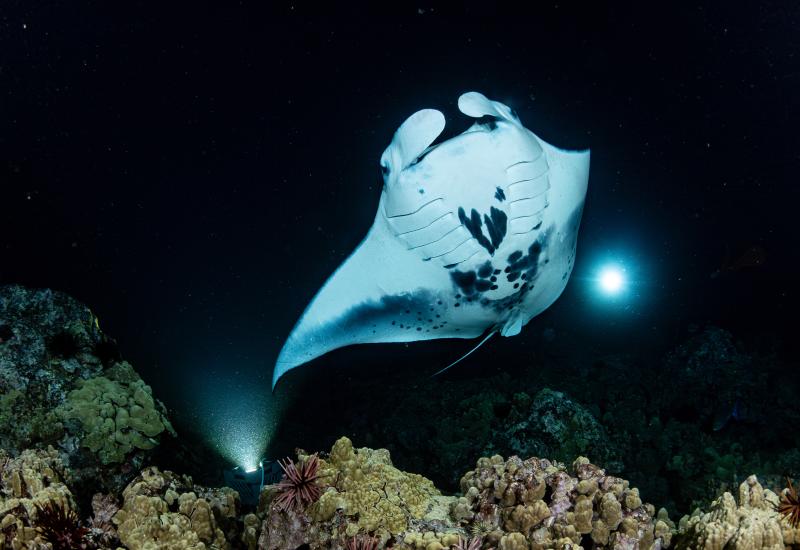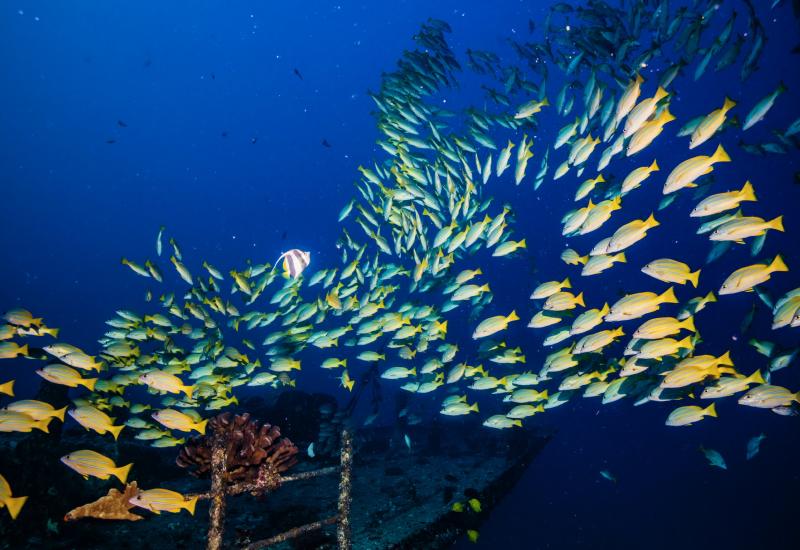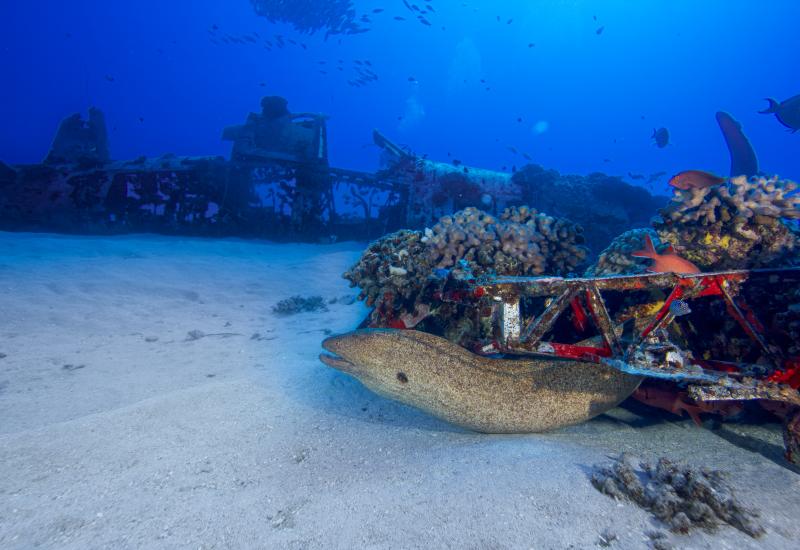Papua New Guinea
 |
| The rare Rhinopias aphanes, or weedy scorpionfish, mimics a crinoid as it lies in wait for prey. |
January 2004
Text and Photography by Stuart & Michele Westmorland
||
|---|
|

|
| With eight wives and many pigs, the Huli witch doctor Pajia is a wealthy man by tribal standards. He earns a living by conjuring spirits, and blending lotions and potions.|
The plane banks over Papua New Guinea's mainland, and beneath you a fern-green jungle blankets the flanks of mountains that drop down to sugar-white sand and into the turquoise Pacific. But underneath the paradise-perfect scenery, Papua New Guinea is a land of immensities and complexities. It is a country of 600 islands spread out over hundreds of miles, with more than 700 languages, a troubled capital city and a ritualistic tribal culture.
This juxtaposition of the rare and wonderful plays out under water, too. Thousands of square miles of coral reef jammed with strange creatures. Water-darkening schools of fish. Dizzyingly deep walls. World War II wrecks. It would take more than a single magazine article to do it justice.
The sites highlighted here illustrate PNG's diversity. Loloata Island offers rare marine species. A trio of islands in the Bismarck Sea--New Britain, New Ireland and New Hanover--is the cruising ground of large pelagics. Finally, Tari Valley is the place to experience PNG's rich tribal culture.
Loloata means "one hill" in Motu, the language spoken locally. Visitors who arrive by boat are immediately greeted by the friendly crew and staff of Loloata Island Resort, which overlooks Bootless Bay. Only 20 minutes from Port Moresby, PNG's capital city, Loloata is a serene retreat where you can spend a day at the beach or enjoy world-class diving. The resort's comfortable dive boats whisk you to a myriad of sites. The pinnacle of Suzie's Bommie, adorned with red sea whips, pink sea fans, and huge barrel and elephant ear sponges, is alive with schools of batfish, sweetlips and other reef fish. Loloata also features a World War II aircraft wreck. The seagrass beds of uninhabited Lion Island shelter lots of small, weird creatures like white-faced morays, chocolate chip sea stars and harlequin pipefish, and is the destination of choice for muck divers.
 |
| Common lizardfish in PNG are bigger than their cousins in other oceans. |
||
|---|
|

|
| In the Southern Highlands, Ambua Lodge's bungalows offer warmth in the cooler mountains.|
The jumping-off point for diving in the Bismarck Sea is Walindi Plantation, a still-operating oil-palm plantation on New Britain Island. Amazed by the biodiversity of Kimbe Bay, owner Max Benjamin built a dive resort and donated land for a nature center. The bay is home to hundreds of species of fish and coral, and the calm waters offer a respite to sperm whales, orcas and large schools of tuna. To reach the outer islands beyond Kimbe Bay in the Bismarck Sea, visitors can board one of three live-aboards that use Walindi as a base. FeBrina, Star Dancer and Paradise Sport can get to the Witus, where jacks and barracuda number in the thousands. It's an overnight crossing to the passes of New Ireland and New Hanover islands (the Kavieng area), where divers can drift-dive in a three-knot current alongside rays and sharks. On the eastern side of Kimbe Bay, the Fathers, named after New Britain's highest and still-active volcano, Mt. Ulauan, or Father, is just west of Lolobau Island. Even though it's in Kimbe Bay, this hook-shaped reef chain, packed with soft corals and gorgonians, is also accessible only by live-aboard. You may encounter a friendly pod of resident dolphins who often play in the boat's wake--and if you're lucky, with divers in the water.
 |
| PNG's waters are thick with hundreds of species of schooling fish like these milkfish. |
The vast and rugged highlands of Papua New Guinea were the last of the country's territories to be explored by Europeans. Hike the lush, high-altitude rain forests of the Tari basin in the Southern Highlands, and you'll be treated to spectacular waterfalls and unusual fauna and flora like flamboyant birds of paradise, a cuddly member of the possum family called the cuscus and rare species of orchids. This is a primal landscape, and home to the tribe of wig-wearers known as the Huli. Fierce warriors, the Hulis are also excellent farmers and hunters. The gardens and domestic chores are tended to by the tribe's women, who often live separately from the men. In the Wig School, young Huli males make amazing, decorated wigs that are used in cultural heritage shows that are popular tourist attractions. The traditional song and dance called sing-sing is performed by brilliantly costumed locals on a regular basis. While the Hulis and other tribes living in the Highlands have been affected by the changes brought by outsiders, it is still possible for visitors to witness a way of life and culture found nowhere else in the world.
 |
| Schools of chevron barracuda can be found throughout Papua New Guinea. |
||
|---|
|

|
| Locals fish and farm in isolated villages that dot PNG's rivers, though they're increasingly exposed to outside influences.|
Dive Conditions > Average water temperatures vary from 77 degrees along the edge of the Coral Sea to 84 degrees in the Bismarck Sea.
Weather > Tropical, with coastal temperatures hovering between 77 degrees and 86 degrees. The wet season is from December to March. Rainfall is heavy, but varies greatly.
Getting There > Most divers fly into the capital of Port Moresby, arriving via connections in Australia (Cairns, Sydney or Brisbane), although you can also connect to Port Moresby through Singapore, New Zealand and the Philippines.
Documents > Passports are required. You can get a 60-day tourist visa (about US$10.25) on arrival, but it's best to obtain one in advance from the PNG Embassy at (202) 745-3680 or at www.pngembassy.org. If your itinerary includes overnight layovers in Australia, you'll also need an Australian tourist visa. It's free, but must be arranged (either on paper or electronically) in advance. Call the Australian Embassy at (800) 242-2878 or visit www.austemb.org.
Currency > The kina (PGK), which fluctuates wildly. At press time, US$1 = PGK3.3. The departure tax must be paid in kinos (about US$9).
Dive Operators > For information on Papua New Guinea dive operators, comprehensive travel guides, special dive deals and recent trip reports submitted by users, click on "TripFinder" at the top of the page.
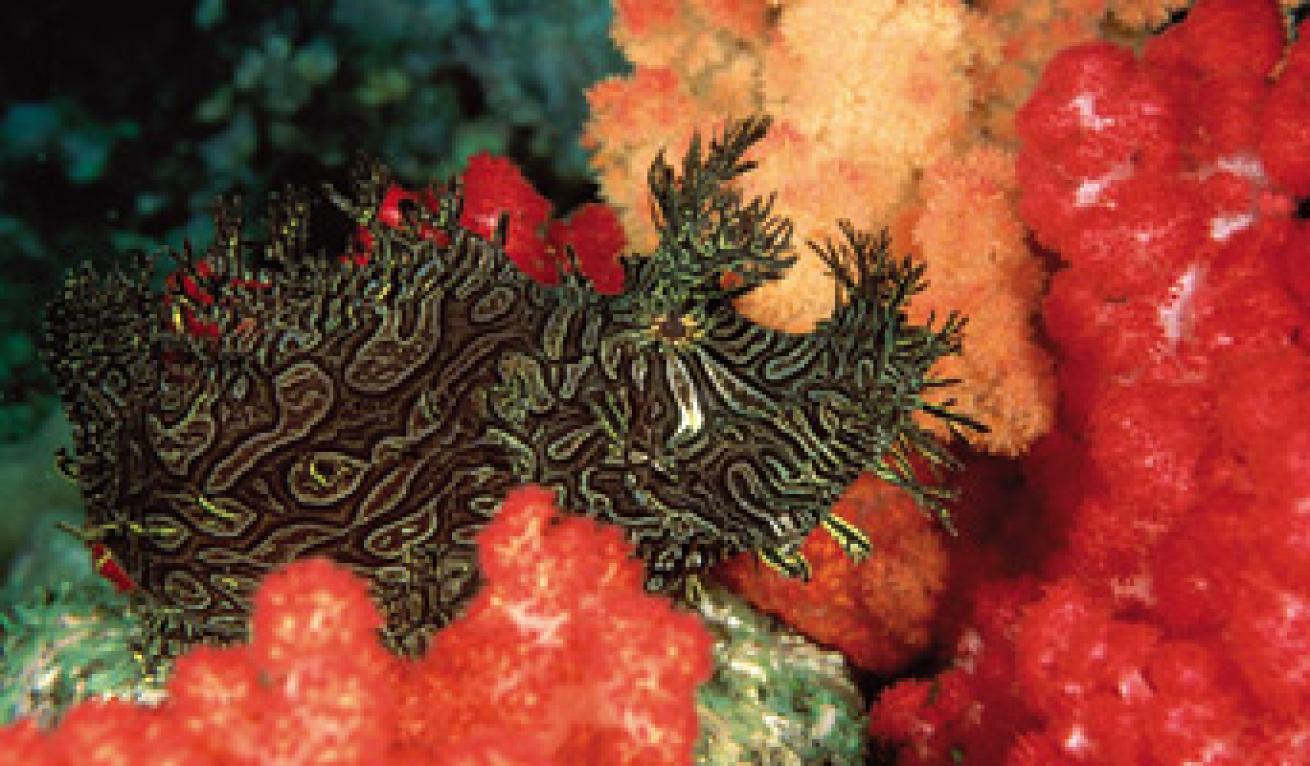
The rare Rhinopias aphanes, or weedy scorpionfish, mimics a crinoid as it lies in wait for prey.
Text and Photography by Stuart & Michele Westmorland
With eight wives and many pigs, the Huli witch doctor Pajia is a wealthy man by tribal standards. He earns a living by conjuring spirits, and blending lotions and potions. The plane banks over Papua New Guinea's mainland, and beneath you a fern-green jungle blankets the flanks of mountains that drop down to sugar-white sand and into the turquoise Pacific. But underneath the paradise-perfect scenery, Papua New Guinea is a land of immensities and complexities. It is a country of 600 islands spread out over hundreds of miles, with more than 700 languages, a troubled capital city and a ritualistic tribal culture.
This juxtaposition of the rare and wonderful plays out under water, too. Thousands of square miles of coral reef jammed with strange creatures. Water-darkening schools of fish. Dizzyingly deep walls. World War II wrecks. It would take more than a single magazine article to do it justice.
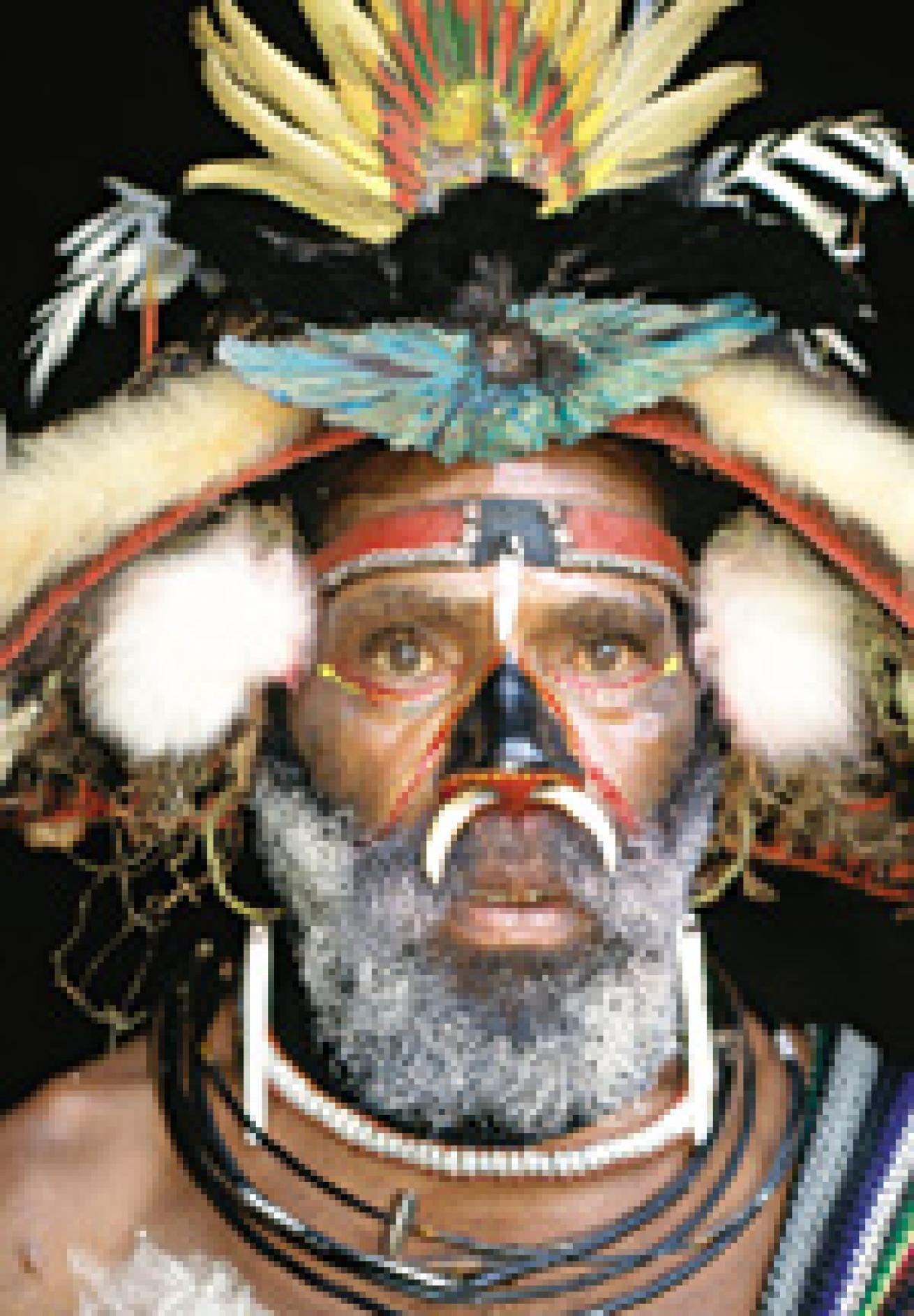
The sites highlighted here illustrate PNG's diversity. Loloata Island offers rare marine species. A trio of islands in the Bismarck Sea--New Britain, New Ireland and New Hanover--is the cruising ground of large pelagics. Finally, Tari Valley is the place to experience PNG's rich tribal culture.
Loloata means "one hill" in Motu, the language spoken locally. Visitors who arrive by boat are immediately greeted by the friendly crew and staff of Loloata Island Resort, which overlooks Bootless Bay. Only 20 minutes from Port Moresby, PNG's capital city, Loloata is a serene retreat where you can spend a day at the beach or enjoy world-class diving. The resort's comfortable dive boats whisk you to a myriad of sites. The pinnacle of Suzie's Bommie, adorned with red sea whips, pink sea fans, and huge barrel and elephant ear sponges, is alive with schools of batfish, sweetlips and other reef fish. Loloata also features a World War II aircraft wreck. The seagrass beds of uninhabited Lion Island shelter lots of small, weird creatures like white-faced morays, chocolate chip sea stars and harlequin pipefish, and is the destination of choice for muck divers.
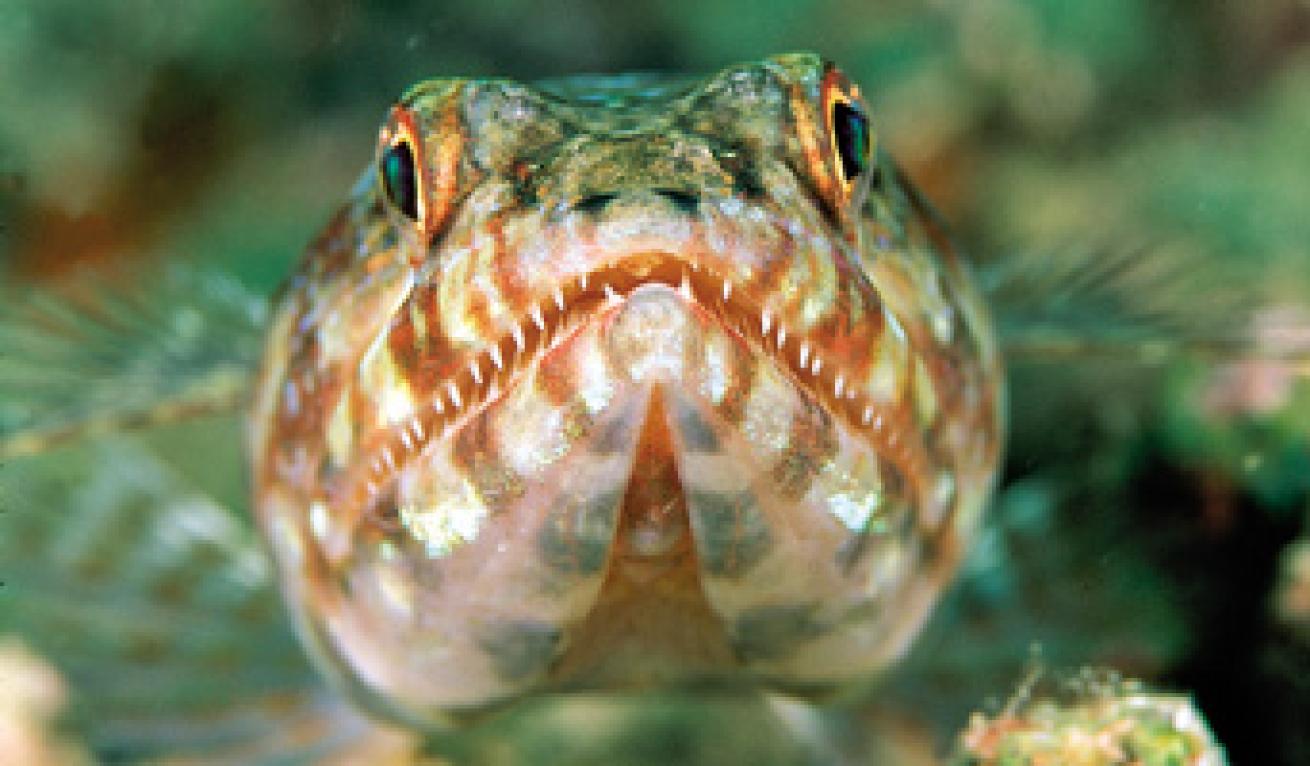
Common lizardfish in PNG are bigger than their cousins in other oceans.
In the Southern Highlands, Ambua Lodge's bungalows offer warmth in the cooler mountains.
The jumping-off point for diving in the Bismarck Sea is Walindi Plantation, a still-operating oil-palm plantation on New Britain Island. Amazed by the biodiversity of Kimbe Bay, owner Max Benjamin built a dive resort and donated land for a nature center. The bay is home to hundreds of species of fish and coral, and the calm waters offer a respite to sperm whales, orcas and large schools of tuna. To reach the outer islands beyond Kimbe Bay in the Bismarck Sea, visitors can board one of three live-aboards that use Walindi as a base. FeBrina, Star Dancer and Paradise Sport can get to the Witus, where jacks and barracuda number in the thousands. It's an overnight crossing to the passes of New Ireland and New Hanover islands (the Kavieng area), where divers can drift-dive in a three-knot current alongside rays and sharks. On the eastern side of Kimbe Bay, the Fathers, named after New Britain's highest and still-active volcano, Mt. Ulauan, or Father, is just west of Lolobau Island. Even though it's in Kimbe Bay, this hook-shaped reef chain, packed with soft corals and gorgonians, is also accessible only by live-aboard. You may encounter a friendly pod of resident dolphins who often play in the boat's wake--and if you're lucky, with divers in the water.
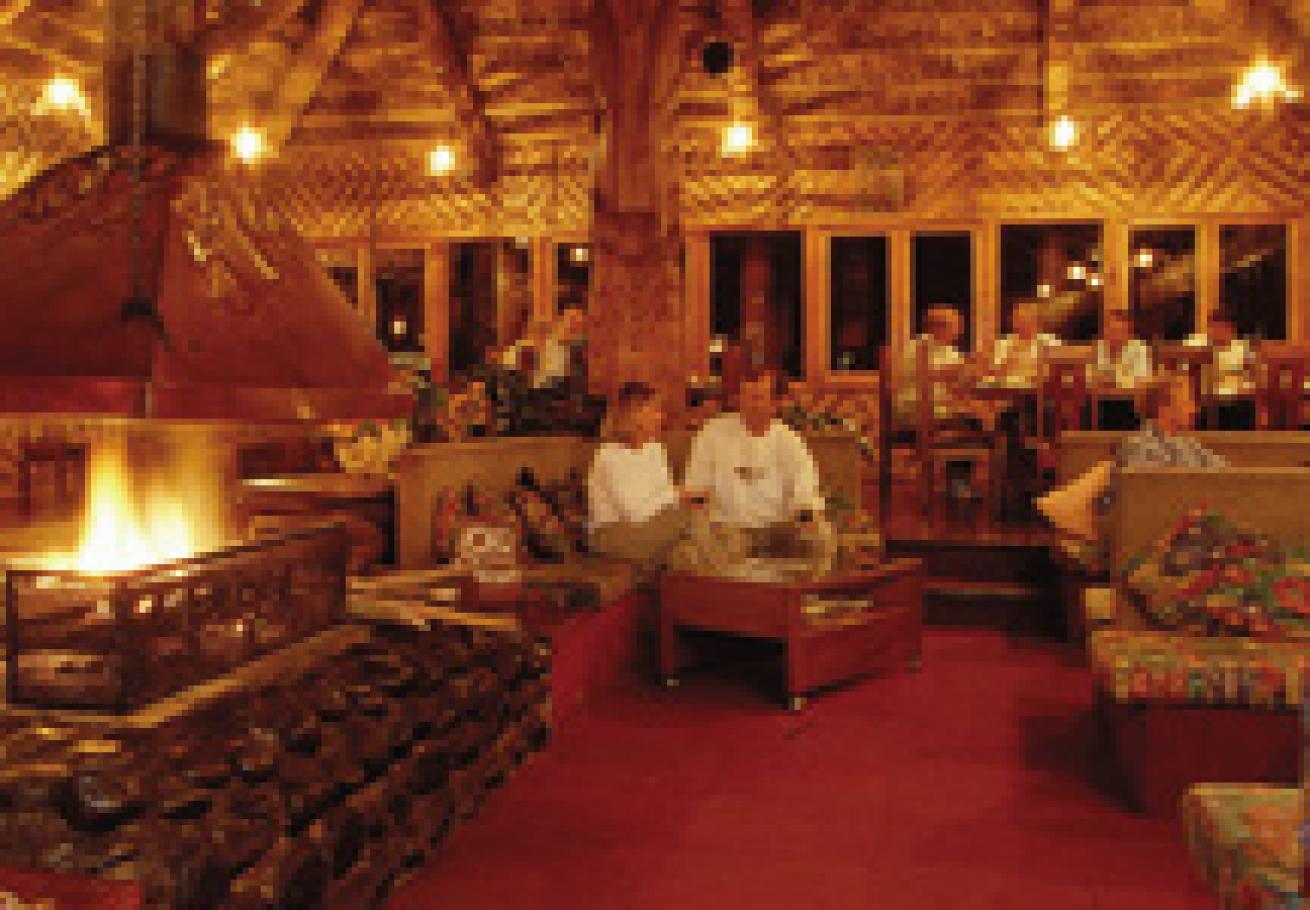
PNG's waters are thick with hundreds of species of schooling fish like these milkfish.
The vast and rugged highlands of Papua New Guinea were the last of the country's territories to be explored by Europeans. Hike the lush, high-altitude rain forests of the Tari basin in the Southern Highlands, and you'll be treated to spectacular waterfalls and unusual fauna and flora like flamboyant birds of paradise, a cuddly member of the possum family called the cuscus and rare species of orchids. This is a primal landscape, and home to the tribe of wig-wearers known as the Huli. Fierce warriors, the Hulis are also excellent farmers and hunters. The gardens and domestic chores are tended to by the tribe's women, who often live separately from the men. In the Wig School, young Huli males make amazing, decorated wigs that are used in cultural heritage shows that are popular tourist attractions. The traditional song and dance called sing-sing is performed by brilliantly costumed locals on a regular basis. While the Hulis and other tribes living in the Highlands have been affected by the changes brought by outsiders, it is still possible for visitors to witness a way of life and culture found nowhere else in the world.
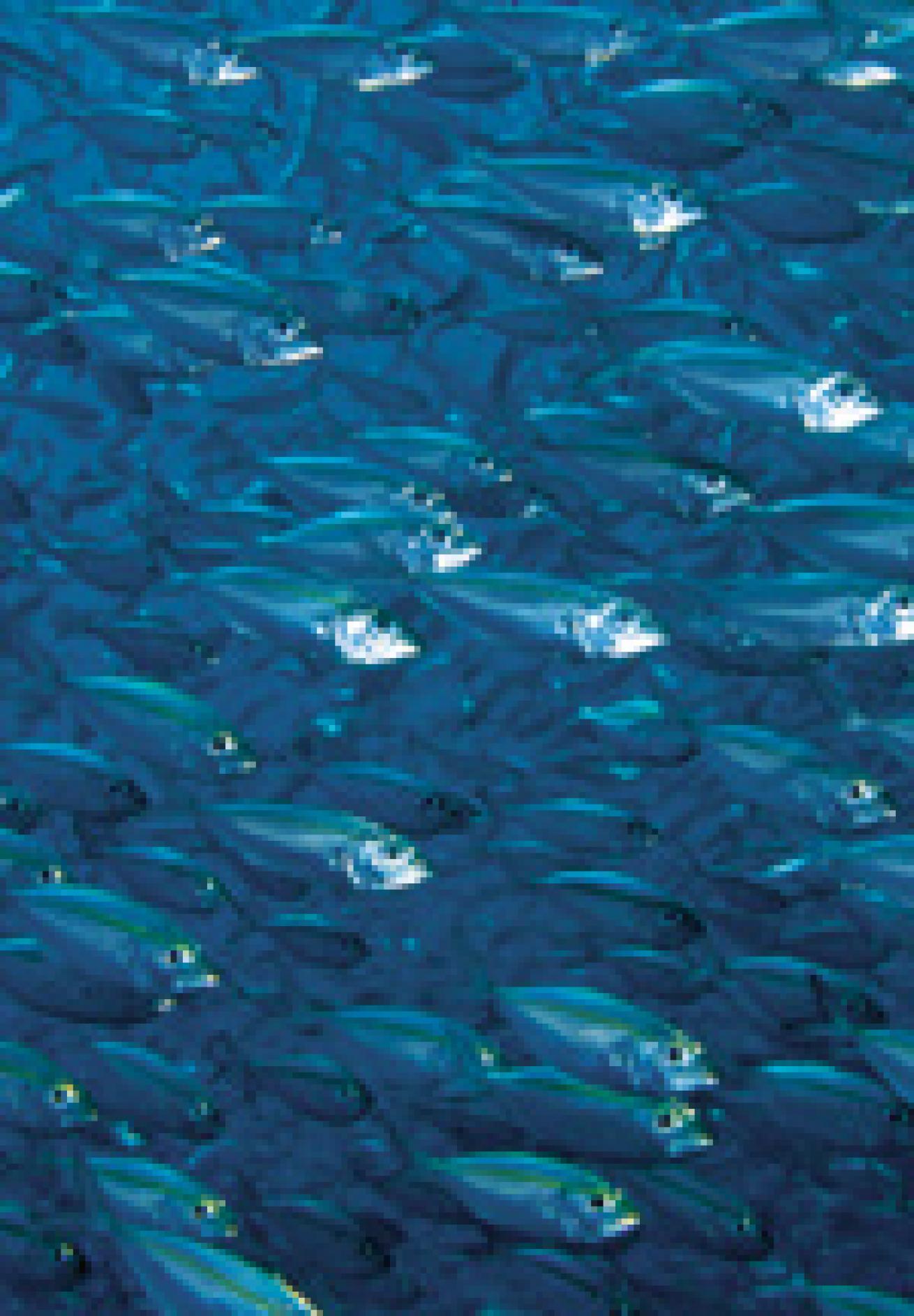
Schools of chevron barracuda can be found throughout Papua New Guinea.
Locals fish and farm in isolated villages that dot PNG's rivers, though they're increasingly exposed to outside influences. Dive Conditions > Average water temperatures vary from 77 degrees along the edge of the Coral Sea to 84 degrees in the Bismarck Sea.
Weather > Tropical, with coastal temperatures hovering between 77 degrees and 86 degrees. The wet season is from December to March. Rainfall is heavy, but varies greatly.
Getting There > Most divers fly into the capital of Port Moresby, arriving via connections in Australia (Cairns, Sydney or Brisbane), although you can also connect to Port Moresby through Singapore, New Zealand and the Philippines.
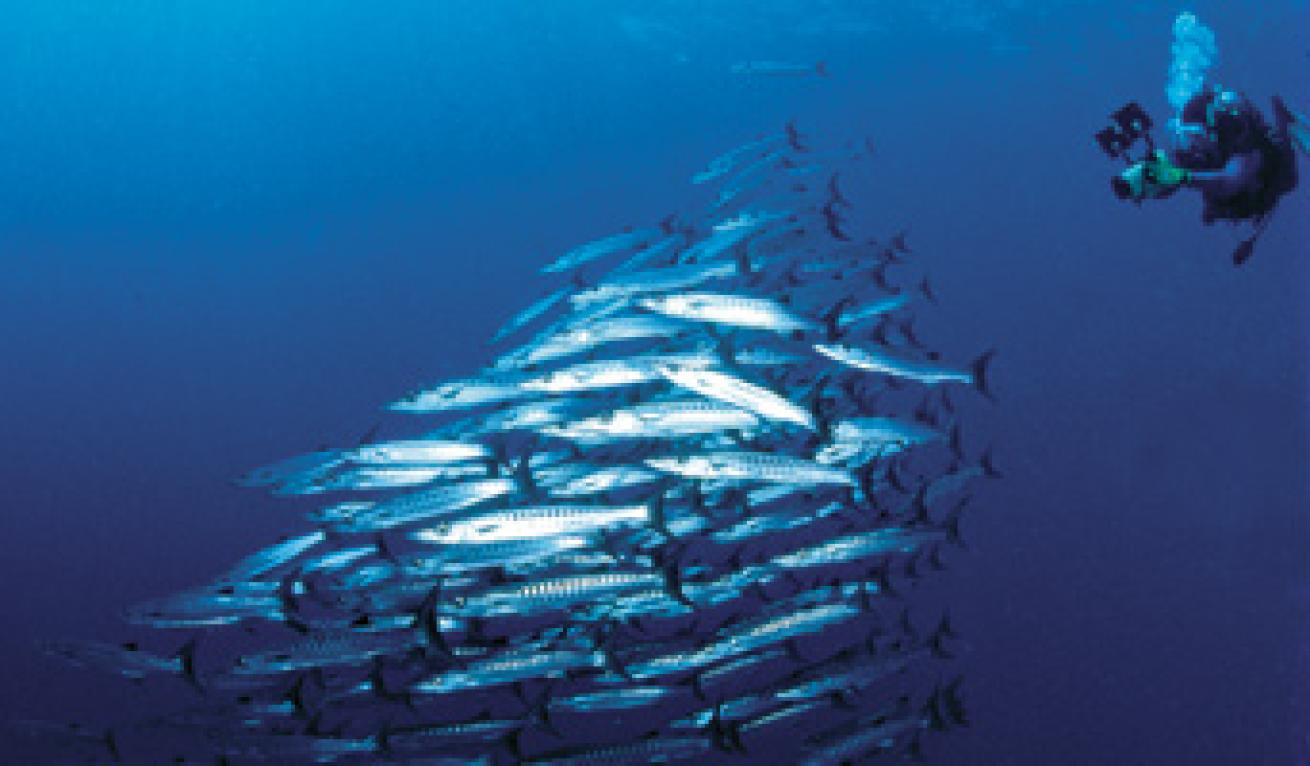
Documents > Passports are required. You can get a 60-day tourist visa (about US$10.25) on arrival, but it's best to obtain one in advance from the PNG Embassy at (202) 745-3680 or at www.pngembassy.org. If your itinerary includes overnight layovers in Australia, you'll also need an Australian tourist visa. It's free, but must be arranged (either on paper or electronically) in advance. Call the Australian Embassy at (800) 242-2878 or visit www.austemb.org.
Currency > The kina (PGK), which fluctuates wildly. At press time, US$1 = PGK3.3. The departure tax must be paid in kinos (about US$9).
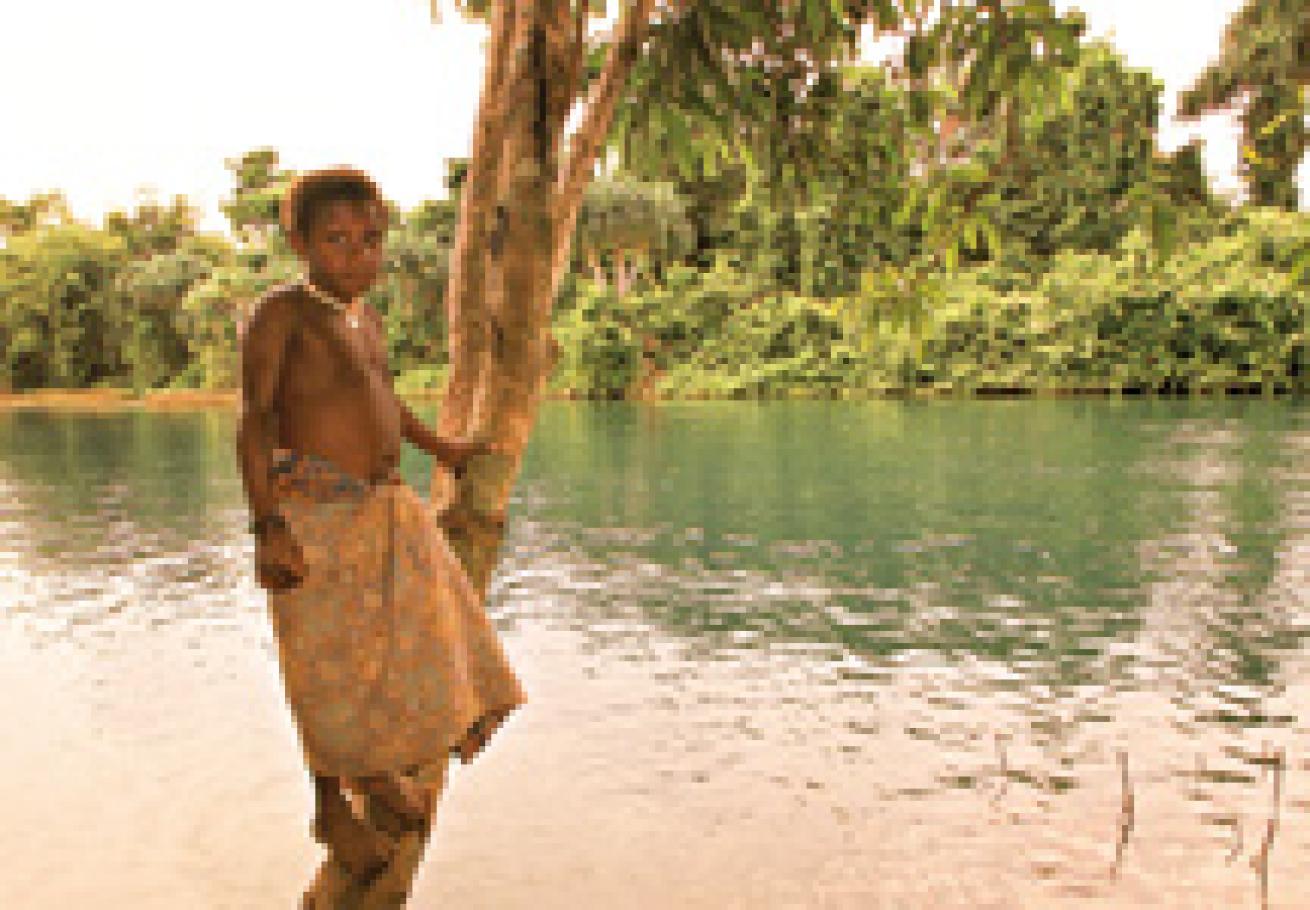
Dive Operators > For information on Papua New Guinea dive operators, comprehensive travel guides, special dive deals and recent trip reports submitted by users, click on "TripFinder" at the top of the page.


